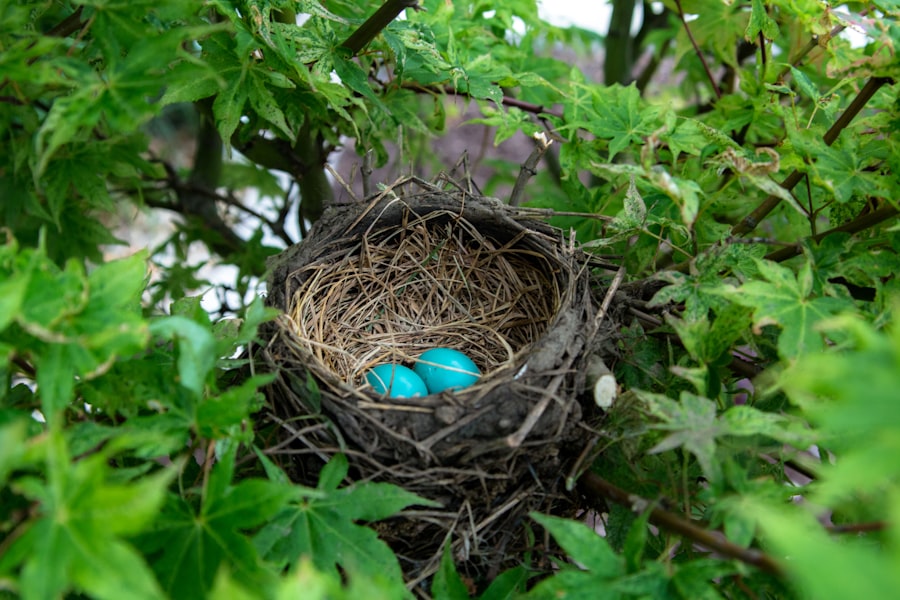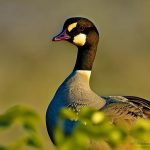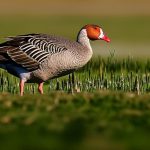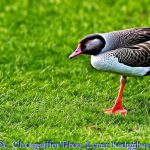Geese are large waterfowl birds that are known for their distinctive honking sound and V-shaped flying formations. They are found in various parts of the world and are known for their strong family bonds and protective nature. Geese typically mate for life and return to the same nesting sites year after year.
Understanding goose nesting habits is crucial for several reasons. Firstly, it allows us to appreciate the unique behaviors and adaptations of these birds. Secondly, it helps us protect their nesting sites, which are essential for their survival and conservation. By understanding where geese choose to lay their eggs and the challenges they face, we can take steps to ensure their safety and promote their population growth.
Key Takeaways
- Geese are birds that lay their eggs in nests, which they build on the ground.
- Finding a safe and secure location for goose eggs is crucial for their survival.
- Factors such as food availability, water access, and predator presence influence where geese choose to lay their eggs.
- Common locations where geese keep their eggs in the wild include grassy areas near water sources and on islands.
- Geese adapt to urban environments by nesting on rooftops, balconies, and other elevated areas.
The importance of finding a safe and secure location for goose eggs
Finding a safe location for goose eggs is crucial for the survival of the eggs and the future generation of geese. Geese invest a significant amount of time and energy into building nests and laying eggs, so it is essential that these efforts are not in vain. A safe location ensures that the eggs are protected from predators, extreme weather conditions, and human disturbances.
Protecting goose nesting sites is also important for conservation purposes. Geese play a vital role in maintaining the balance of ecosystems they inhabit. They help control vegetation growth, disperse seeds, and provide food for other animals through their droppings. By protecting their nesting sites, we are ensuring the continued existence of these important ecological processes.
Factors that influence where geese choose to lay their eggs
Several factors influence where geese choose to lay their eggs. One of the most critical factors is the availability of food and water sources. Geese need access to both freshwater bodies and grassy areas with ample vegetation to feed on during the nesting period.
Safety from predators is another crucial factor that influences nesting site selection. Geese prefer locations that provide good visibility and are away from potential threats such as foxes, raccoons, and other predators. They often choose areas with tall grasses or near water bodies, as these provide natural barriers against predators.
Common locations where geese keep their eggs in the wild
In the wild, geese commonly lay their eggs in a few specific locations. One of the most common nesting sites is near water sources such as lakes, ponds, or rivers. These areas provide easy access to food and water for both the adult geese and their goslings once they hatch.
Geese also choose to nest in tall grasses or vegetation. The tall grasses provide cover and protection from predators, making it difficult for them to approach the nest undetected. The dense vegetation also helps keep the eggs warm and provides a suitable environment for incubation.
How geese adapt to urban environments when nesting
Geese have shown remarkable adaptability when it comes to nesting in urban environments. As natural habitats continue to be encroached upon by human development, geese have found ways to make use of man-made structures for nesting. They have been observed nesting on rooftops, balconies, and even in parks within urban areas.
These adaptations allow geese to find safe locations away from predators and disturbances caused by human activity. Urban environments often provide a more stable food source for geese as well, with manicured lawns and parks offering ample grazing opportunities.
Challenges faced by geese when nesting in urban areas

While geese have adapted to nesting in urban environments, they still face several challenges. Increased human activity can disturb nesting sites and cause stress to the birds. Noise pollution, construction activities, and even well-meaning but misguided human interference can disrupt the nesting process and lead to abandonment of nests.
Urban areas also expose geese to pollutants such as pesticides and chemicals that can be harmful to both the adults and their young. The lack of natural vegetation and water bodies can also limit the availability of suitable nesting sites, forcing geese to make do with less-than-ideal locations.
The role of human intervention in protecting goose nests and eggs
Human intervention plays a crucial role in protecting goose nests and eggs in urban areas. By understanding the challenges faced by geese, we can take steps to mitigate them and create safe environments for nesting. One way to protect nesting sites is by creating barriers or fencing around them to prevent human disturbance and deter predators.
Providing nesting boxes or platforms in suitable locations can also help create safe spaces for geese to lay their eggs. These artificial structures mimic natural nesting sites and offer protection from predators. Additionally, educating the public about the importance of respecting goose nesting sites and avoiding disturbances can go a long way in ensuring their safety.
How geese defend their nests and eggs from predators
Geese are known for their aggressive behavior when it comes to defending their nests and eggs from predators. When threatened, they will hiss, flap their wings, and even charge at intruders. Their large size and strong beaks make them formidable opponents, capable of inflicting injury on potential threats.
Geese also use their honking calls as a means of communication and defense. The loud honking not only alerts other geese in the vicinity but can also startle predators and deter them from approaching the nest. These defensive behaviors are essential for ensuring the survival of the eggs and protecting the future generation of geese.
The hatching process and care of goslings after they are born
The hatching process for goose eggs typically takes around 28-30 days. Once the eggs hatch, the goslings are precocial, meaning they are relatively independent from birth. However, adult geese still play a crucial role in caring for their young.
Adult geese provide warmth and protection to the goslings, often huddling together to keep them warm. They also guide their young to suitable feeding areas and teach them how to find food. Adult geese are fiercely protective of their goslings and will defend them from predators or any perceived threats.
Conclusion and the importance of protecting goose nesting sites for conservation
In conclusion, understanding and protecting goose nesting sites is crucial for the conservation of these magnificent birds. By providing safe and secure locations for geese to lay their eggs, we are ensuring the survival of future generations and promoting the overall health of ecosystems they inhabit.
Human intervention plays a vital role in protecting goose nests and eggs, whether in urban or natural environments. By creating barriers, providing nesting boxes, and educating the public about the importance of respecting nesting sites, we can help ensure the safety of geese and their young.
It is our responsibility to protect these nesting sites for the conservation of geese and their habitats. By taking action to preserve these areas, we are not only safeguarding the future of geese but also contributing to the overall biodiversity and health of our planet.
If you’re curious about where geese keep their eggs, you might also be interested in learning about the ideal location for a chicken coop. Poultry Wizard has a helpful article on “Where to Put Your Chicken Coop” that provides valuable insights on selecting the right spot for your feathered friends. Understanding the importance of factors like sunlight, drainage, and predator protection can greatly contribute to the health and productivity of your flock. To read more about this topic, check out the article here.
FAQs
What is the nesting behavior of geese?
Geese are known to be monogamous and mate for life. They build their nests on the ground, usually near water bodies, and lay their eggs in it.
Where do geese keep their eggs?
Geese keep their eggs in their nests, which they build on the ground. They prefer to build their nests in areas that are well-hidden and protected from predators.
How many eggs do geese lay?
Geese typically lay between 4 to 8 eggs in a single clutch. However, some species of geese can lay up to 12 eggs in a clutch.
How long does it take for geese eggs to hatch?
Geese eggs take around 25 to 30 days to hatch. During this time, the female goose incubates the eggs and keeps them warm.
Do male geese help in incubating the eggs?
Yes, male geese do help in incubating the eggs. They take turns with the female goose to incubate the eggs and protect the nest from predators.
What happens after the eggs hatch?
After the eggs hatch, the goslings (baby geese) stay with their parents for several weeks. The parents take care of them, protect them from predators, and teach them how to find food and survive in the wild.
Meet Walter, the feathered-friend fanatic of Florida! Nestled in the sunshine state, Walter struts through life with his feathered companions, clucking his way to happiness. With a coop that’s fancier than a five-star hotel, he’s the Don Juan of the chicken world. When he’s not teaching his hens to do the cha-cha, you’ll find him in a heated debate with his prized rooster, Sir Clucks-a-Lot. Walter’s poultry passion is no yolk; he’s the sunny-side-up guy you never knew you needed in your flock of friends!







